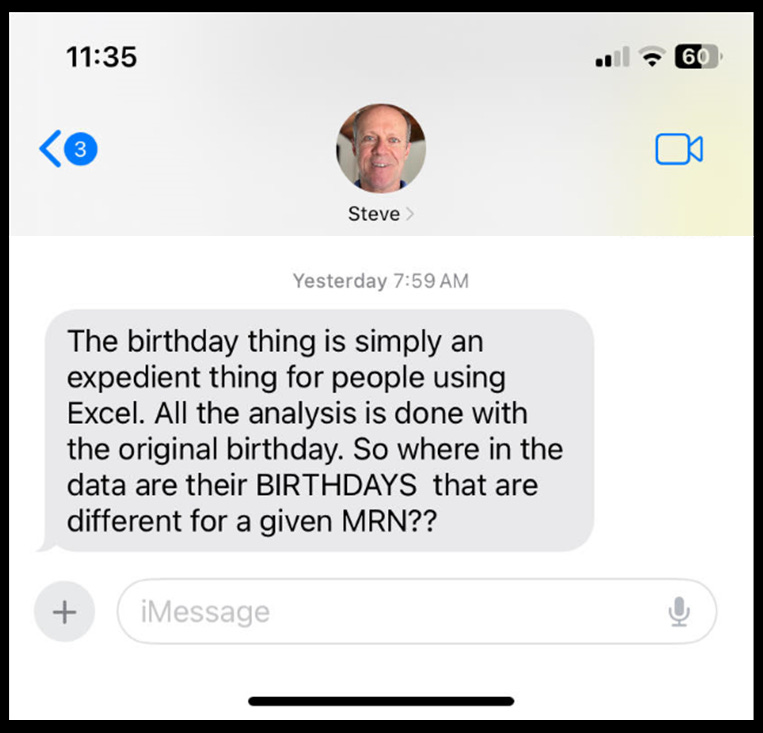P19 New Zealand Data - Steve's Riddle About Victim's Ages...
Alert: Don't calculate by the "age" field, it's off by 1-3yrs...
Part 18 HERE : HYPOTHETICAL DASHBOARD HERE
In my last article I basically tried to add some color to OpenVAET & Arkmedic’s “Nothing burger” article about Steve Kirsch’s time series cohort analysis. It was a mini breakthrough for me as I got responses from all the players like OpenVAET, Arkmedic, Mongol and even Steve Kirsch himself.
In short, I didn’t agree with the nothing burger article, not because of any flaws in the calculations but because I believe these jabs are dog shit and a depopulation tool by intelligent evil design. I think the same of all vaccines and it’s why I have never been vaxxed and never had a flu shot, thank you Momma! Tiny disclaimer, I got one PPD skin test and I drank the kool-aid once and got one Pneumovax vax or something for a Director job for PMG of San Jose (Excel MSO) once. Stupid me, I took the carrot.
I went into the nothing burger article wanting to find a signal rather than letting the data drive my decisions. Oh well. I basically came out of left field and presented a precise observation that the average age of death in the Barry/Kirsch data set is 78.92 yrs which is well below the 82.80yrs average life expectancy of New Zealand.
I threw out some typical disclaimers about small inconsistencies in the data most matching with what Igor Chudov mentions in previous observations. A couple things I haven’t confirmed for myself about Igor’s assertions is:
"In 586 rows, the same subject doesn’t have the same date of birth than in a previous row. In 226 rows, the same subject doesn’t have the same age than in a previous row (with variations by several decades)."
These were the exact two points that prompted Kirsch to text me for confirmation:
As I was setting myself up to go on the hunt for Igor’s assertions when I discovered a bigger flaw in my opinion and thanks in part to a caveat Mongol noted about analyzing age cohorts based off the “age” column supplied by Kirsch’s synthesized data dump…:
I quickly understood the minutiae in this technical explanation. It basically means the “age” column is basically off anywhere from 1-3yrs because the age column is calibrated to how old the victim was at the date of Kirsch’s synthesis, not at the age of vaccination or even at the age of death. These are two very important distinctions. Here is a screen grab and a short video of what this looks like:
Kirsch is a pretty precise guy, but I think I figured out why he would tell Brannon Howse the ages in his derivative data dump are off by 1-2yrs, but he told me the D.O.B.’s were off by no more than 14 days…
Here is what Steve told Howse:
Here is Steve telling me, “everyone was changed by less than 14 days…”.:
So there you have it. Steve must know what I discovered and what I’m sharing now about Steve’s age column and how/why it differs so much from the actual age at time of vaccination or age at death. I think it’s also the reason he didn’t ask about or rebuttal anything I’ve said about age column not matching the victims actual age at vax or death date… I guess it’s only an expedient.
“The birthday thing is simply an expedient thing for people using Excel…”
I just realized how important the birthdate field is and makes a material difference as opposed to just running with Steve’s age column, eh? This so much reminds me of the game of chess. There are chess masters and chess players. Just like coding languages “R”, Python, SQL, Ruby on Rails, etc… There are people that have learned “R” and people that have only learned to play with “R”. Congrats to the folks with the wisdom to know the difference. Ironically, there are many “R”, Python, and SQL experts that aren’t very savvy with Excel and vice versa.
I know I still haven’t answered Steve’s original question that was basically me regurgitating Igor’s observations, especially the observation that some ages of the SAME SUBJECT are off by several decades? Here is my call to Igor: Can you produce a list of these records Igor? Any lists where the records of dob’s are different within the same victim? I think you also noticed as have I some doses that look like they need to be fixed? Meaning dude has an entry for two “dose 3’s” but upon examination, one line needs to be changed to dose 4 based on vaccination date…
It would be nice if I could build on Igor’s or someone’s hard work and create a better more precise interactive (hypothetical) dashboard by getting the list of anomalies. If I don’t I still may be inclined to just slap this data in the lips and ethically cleanse and rebuild this data myself. This is well within my wheel house. This Barry/Kirsch data is still much better than what VAERS regurgitates out in terms of populated age fields, death dates, and vax dates, and doses.
I’d like to finish this thing off by saying it’s wishful thinking to say all’s the gatekeepers need to do is create this or that system or method to capture the precise data and publish it on some opensource website. That’s exactly what the pharma cabal does not want to do! It would be game over. The whole enchantment of vaccines to save the planet would be over. It should be over. Besides, they already have the complete data between pharma, governments, and pharmacovigilance tools. They probably know what you had for breakfast on the day of your depop shot. You’re living in a fairytale if you think they don’t know.
The whole world will be fooled by pharmakeia! Where have I heard that before?
Rev 18:23 God Bless
Support The Eagle pretty Please!










The age in the age column is not always off by 1-3 years relative to the age at vaccination, because some people were vaccinated in 2023 after their birthday in 2023. The difference between the age column and the age at vaccination is between 0 and 3 years, and the most common difference is 2 years:
> t=as.data.frame(data.table::fread("nz-record-level-data-4M-records.csv"))
> for(i in grep("date",colnames(t)))t[,i]=as.Date(t[,i],"%m-%d-%Y")
> library(lubridate);table(t$age-(t$date_of_birth%--%t$date_time_of_service)%/%years())
0 1 2 3
256801 1042553 2571549 322535
You said that Kirsch told you that "the D.O.B.’s were off by no more than 14 days". However on Kirsch's S3 server, the file `data-transparency/Code/time-series analysis/obfuscation_algorithm.txt` says: "For each person, a non-zero date offset was chosen from a gaussian distribution with sigma=7 and all of the dates for that record were offset for that same amount, so the differences between dates are identical." It's followed by this Python code: `date_delta = 0; while date_delta == 0: date_delta = int(random.normalvariate(0,1) * 7)`. The file doesn't mention anything about a 14-day limit, and only about 95.5% of a normal distribution falls within 2 standard deviations from the mean.
Accurae Assessments. The most prescient point is that the Quaxcines are all harmful and none are safe or effective. The rest of the analysis may be interesting for some though it is true that evidence changed no ones mind, ever.